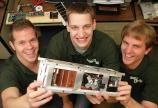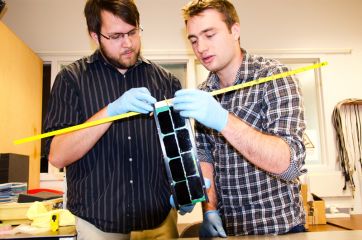Students aim to send satellite into space
- Mitch Wright

University of Victoria students are aiming to take their engineering expertise to new heights.
The university’s extracurricular ECOSat team was one of three finalists out of 12 university teams competing in the Canadian Satellite Design Challenge, which wrapped up Sept. 29 in Ottawa with the announcement of a second offering of the competition with similar parameters.
The inaugural Canada-wide competition required university teams to design and build a small, low-cost satellite to full space-qualification standards, with the winning entry (Concordia) intended to be launched to conduct scientific research.
UVic’s entry met the size standard—about the size of a 2-litre milk carton—was packed with instrumentation for a number of experiments involving magnetic fields, including a pioneering effort to control the satellite’s movement in space using only electromagnetic stabilization.
“It’s never been tried before,” says Justin Curran, a fourth-year electrical engineering student and the team’s chief engineer. “On paper it works, we just need to try it in space.”
The UVic team overcame a number of challenges in getting a working satellite to Ottawa, including learning about and starting the two-year competition months after it was announced.
“It was an all-out blitz right to the end just to keep things working,” Curran says, adding that the time crunch meant the satellite was sent minus a few crucial printed circuit boards. The other two finalists brought fully functional ‘nano-sats,’ although one didn’t meet the size requirement.
The only exclusively undergraduate team among the final three, the ECOSat team also had the lowest budget ($25,000), which they raised largely due to “amazing support” from both the university and business around Victoria, Curran says.
Larry Reeves, a director with the non-profit organization that offers the competition, says testing for the second offering should occur in mid-May 2014.
“It’s quite an aggressive, challenging schedule,” he says, adding that while the competition parameters dictate size and weight of the satellite, the scientific instruments and experiments are entirely up to the students.
With the lessons learned from the first offering of the competition—as well as the recent launch of UVic’s Centre for Aerospace Research directed by Prof. Afzal Suleman, who mentored the first ECOSat effort—the team is already working to put the pieces in place for a strong entry in the next round, and hopefully send an example of UVic engineering excellence into orbit in the spring of 2014.
More: www.csdc.uvic.ca


